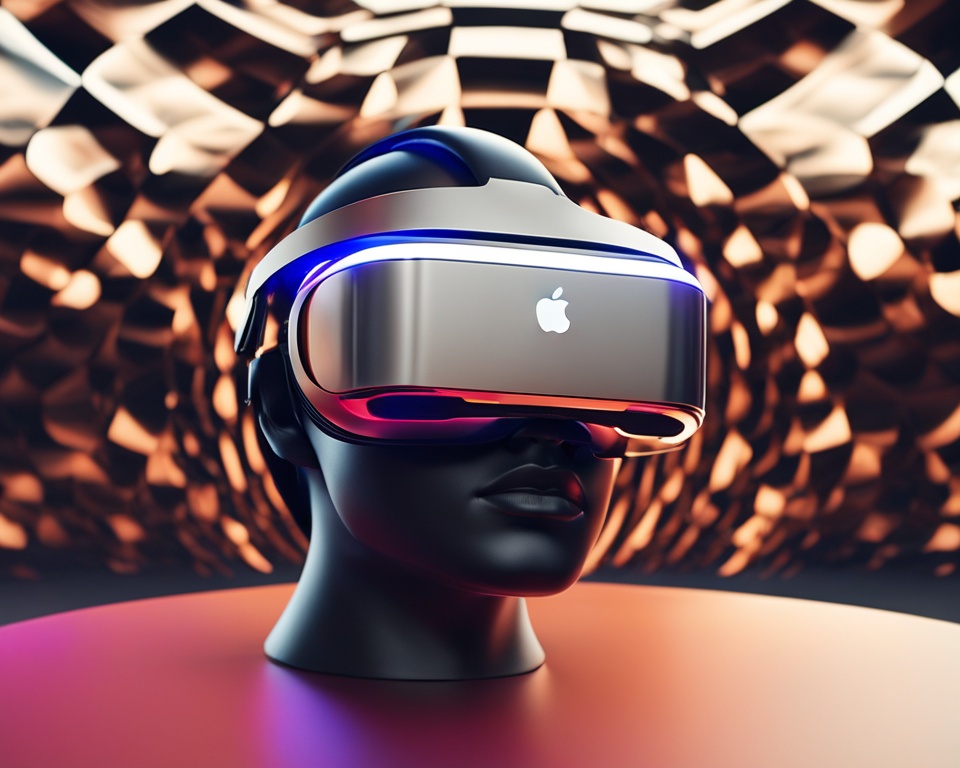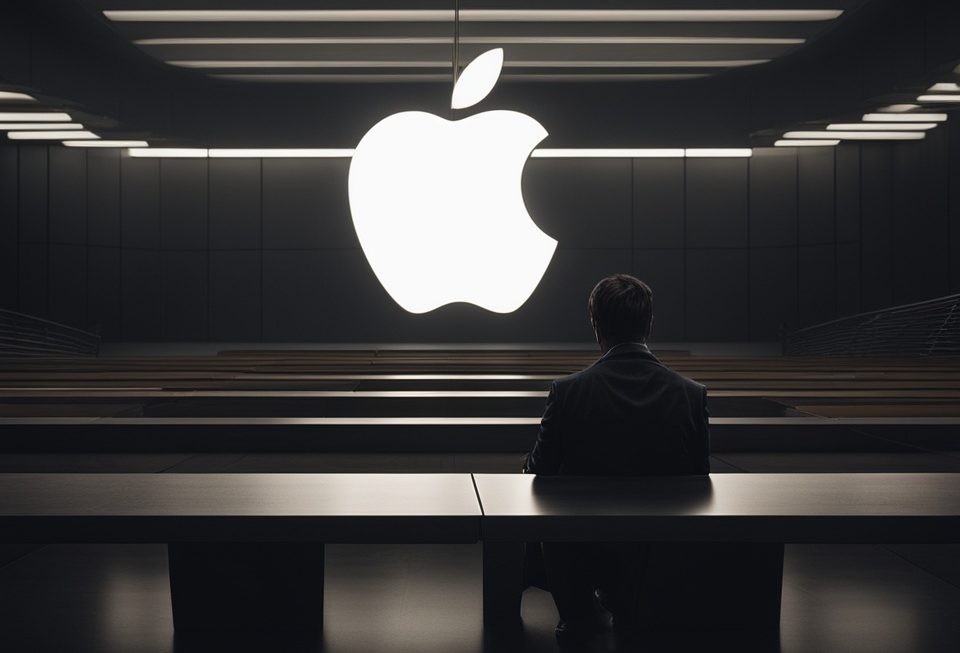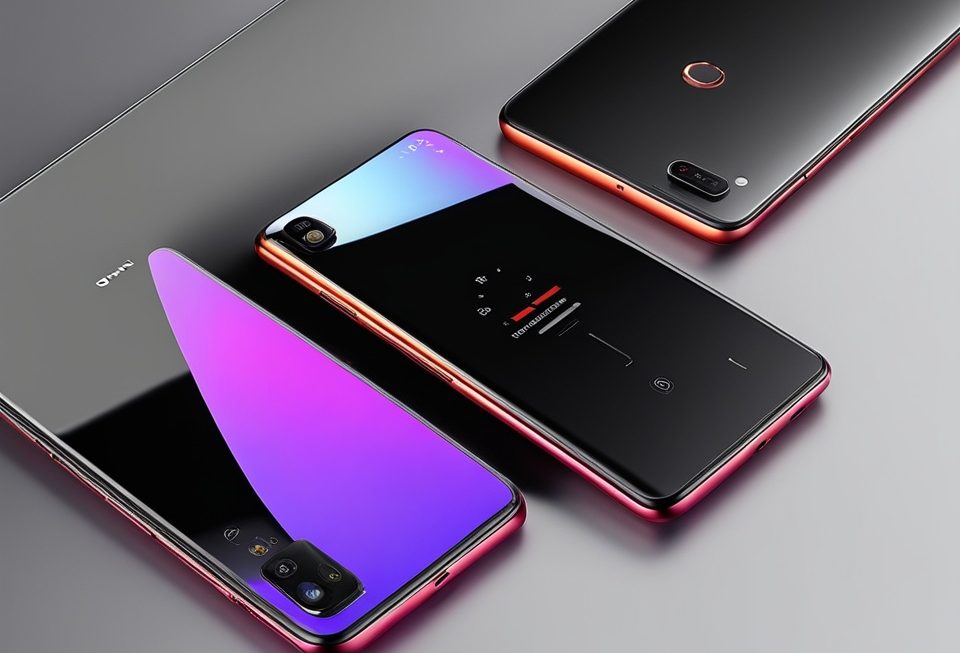Apple has made a surprising move by cancelling its Vision Pro mixed reality headset. This news has shocked the tech world, making people curious about the reasons behind it. We’ll explore what led Apple to stop this project, its effects on their AR/VR goals, and what it means for the mixed reality field.
The Vision Pro was a big deal when it was first shown. It was seen as a game-changer for how we use digital content. But now, its cancellation has left many wondering about Apple’s future in spatial computing and how they’ll handle the challenges of this fast-changing market.
Read more interesting information at ::sportsnews1
Apple’s Shocking Move: Abandoning the Vision Pro
Tech giant Apple has made a surprising move by canceling its apple vision pro headset. This decision has caused a stir in the tech world. It makes people wonder about Apple’s plans for the apple metaverse and its ability to stay innovative.
Why the Tech Giant Pulled the Plug
Apple decided to stop working on the Vision Pro due to technical issues and market concerns. They found it hard to make the hardware perform well, improve battery life, and give users a great experience. This made it tough to meet the high expectations for this new device.
Also, Apple thought the market wasn’t ready for a high-end AR headset. They worried about slow adoption and limited appeal. This led them to cancel the project.
The Ripple Effect on Apple’s AR/VR Ambitions
The cancellation of the apple vision pro affects Apple’s AR and VR plans. The company saw the Vision Pro as a key product for its apple metaverse goals. Now, they must find new ways to lead in mixed reality.
This decision will impact Apple’s ecosystem. They need to win back trust from partners and customers. Apple must rethink its strategy and tackle the challenges it faced with the Vision Pro.
apple vision pro cancelled
Apple has surprised everyone by canceling its Apple Vision Pro. This was a cutting-edge augmented reality (AR) and virtual reality (VR) headset. The news has rocked the tech world, making people curious about Apple’s plans for spatial computing.
The Apple Vision Pro was set to change how we use digital content. But after years of work and big investments, Apple decided to stop the project. They said it was due to technical problems and doubts about the market.
| Timeline of Events | Key Reasons for Cancellation |
|---|---|
|
|
The apple vision pro cancellation has let down fans and made people question Apple’s plans for apple virtual reality investments. This move shows Apple’s careful approach to new tech. They aim for products that are top-notch in user experience and market appeal.
“Apple has always been known for its meticulous attention to detail and unwavering pursuit of perfection. The cancellation of the Vision Pro suggests that the company was not fully satisfied with the product’s readiness for the mass market.”
This setback might slow Apple’s AR/VR progress. But, it’s likely Apple will keep looking at new ways and tech to stay ahead in spatial computing. Experts think Apple’s ability to bounce back and learn from mistakes will guide its future in AR/VR.
Dissecting the Factors Behind the Cancellation
The decision to cancel the Apple Vision Pro was not taken without careful thought. Apple looked deeply into the augmented reality hardware project. They found several key issues that led to stopping the device.
Technical Challenges and Hardware Limitations
Apple faced big technical challenges with the Vision Pro. They struggled to make a headset that was both light and powerful. They had to balance battery life, cooling, and putting all the parts together smoothly.
- Battery life was a big problem, making it hard for users to enjoy the headset for a long time.
- Keeping the headset cool during long use was another big challenge.
- Putting all the needed parts into a small, comfy headset was very hard.
Market Readiness and Consumer Demand
Apple also worried about if the market was ready for a pricey mixed reality headset. The Vision Pro was set to cost $3,499, which was too much for most people. They didn’t want to spend that much on new tech.
“The Vision Pro’s projected cost of $3,499 posed a significant barrier to mainstream adoption, as the majority of consumers were unwilling to invest in such an expensive device, especially for an emerging technology.”
Also, Apple saw that not many people wanted to pay for a top-notch mixed reality experience. This made them decide to cancel the apple vision pro project.
The Future of Apple’s Augmented Reality Efforts
Apple’s augmented reality (AR) plans took a surprising turn with the cancellation of the Apple Vision Pro. But this doesn’t mean they’re giving up on AR. They might be looking at new and creative ways to move forward with their spatial computing project.
Apple might focus more on making AR experiences that are easier to get into and don’t cost a lot. The Vision Pro was too pricey for many people. By making AR more affordable, Apple could get more people to try it out.
The apple spatial computing initiative axed might make Apple rethink how they spend on research and development. They could look into adding AR to things like iPhones and iPads. Or they might come up with new ways to use AR that people will like better.
| Key Considerations | Potential Strategies |
|---|---|
| Accessibility and Affordability | Develop more affordable AR solutions to reach a wider consumer base |
| Alternative AR Experiences | Explore AR integration into existing Apple products or new form factors |
| apple vision pro cancelled | Refocus R&D efforts on more practical and market-ready AR technologies |
Even with the apple vision pro cancelled, Apple is still all in on spatial computing. They have the money, talent, and history of innovation to keep pushing AR forward. The future of apple spatial computing initiative axed efforts could be full of surprises, changing the AR world for the better.
“The future of augmented reality at Apple is not defined by a single product, but by the company’s ability to adapt and innovate in this rapidly evolving space.”
Implications for the Mixed Reality Landscape
The cancellation of the Apple Vision Pro has caused a stir in the mixed reality world. It has led to reactions and new chances for Apple’s rivals. With Apple stepping back from immersive computing, the field is changing. Other companies are now fighting for their spot in the fast-changing AR/VR market.
Competitors’ Reactions and Opportunities
With the Vision Pro gone, other tech giants are jumping at the chance to fill the gap. Apple’s immersive computing abandonment has caught the eye of companies like Meta, Microsoft, and Google. They’re focusing more on their mixed reality products. They’re studying why apple vision pro cancelled to use Apple’s mistakes to their advantage and strengthen their market position.
- Meta, the company behind Facebook, has launched its new VR headset, the Meta Quest 3. It’s seen as a rival to the cancelled Vision Pro.
- Microsoft is set to grow its HoloLens AR solutions for professionals and industries. This was an area Apple aimed to enter with the Vision Pro.
- Google is looking into making AR glasses and investing in spatial computing. They want to offer easy-to-use mixed reality experiences.
These companies are watching the apple vision pro cancelled news closely. They’re looking for ways to stand out and meet the changing needs of users and businesses in mixed reality.
“The cancellation of the Vision Pro has left a void in the market, and our competitors are eager to fill that gap with their own innovative solutions. This is a pivotal moment for the mixed reality industry, and we’re poised to see some exciting advancements in the coming years.”
Apple’s Pivot: Exploring Alternative Strategies
Apple’s decision to cancel the Vision Pro headset has left the tech world stunned. Now, the company is looking at new ways to stay ahead in the AR and VR world. They aim to keep their spot in this fast-changing field.
One idea is to make apple ar/vr headset experiences more accessible. By offering affordable and easy-to-use AR/VR solutions, Apple can reach more people. This could help make AR/VR technology a part of everyday life.
- Streamlining the hardware design to reduce costs and complexity
- Investing in intuitive software and user interfaces to enhance accessibility
- Exploring partnerships with third-party developers to expand the ecosystem
Apple might also look for new partners to work with. By teaming up with other tech companies, research groups, or content creators, Apple can bounce back from the Vision Pro cancellation. This could help them stay strong in the mixed reality market.
| Potential Partnerships | Potential Benefits |
|---|---|
| Gaming platforms | Accelerate the development of immersive gaming experiences |
| Enterprise software providers | Enhance productivity and collaboration in the workplace |
| Educational institutions | Develop innovative learning tools and experiences |
Apple is at a crossroads, and how they respond will shape their future in the apple vision pro cancelled and AR/VR markets. Their ability to adapt and find new paths will be key. With a smart approach, Apple could still offer groundbreaking experiences to its customers.

The Impact on Apple’s Metaverse Aspirations
The cancellation of the Apple Vision Pro has caused big waves in the tech world. It makes people wonder about Apple’s plans for the apple metaverse ambitions halted. Now, Apple is stepping back from its VR headset project. This move affects their metaverse plans and future investments in immersive computing.
Rethinking Virtual Reality Investments
After the apple vision pro cancelled, Apple is being more careful with its VR and AR projects. The technical issues and market doubts about the Vision Pro have made them rethink their metaverse plans.
- Increased focus on AR: Apple might focus more on AR, using its iOS ecosystem and users.
- Scaled-back VR investments: The company will be more careful with VR hardware and software investments, focusing on successful projects.
- Emphasis on software and ecosystem: Apple will focus on developing strong software and integrating its metaverse into its devices and services.
These changes could greatly affect the mixed reality world. Apple’s actions often lead the industry and help shape the use of new technologies.
| Metric | Apple Vision Pro | Future VR Investments |
|---|---|---|
| Hardware Focus | High | Moderate |
| Software Integration | Moderate | High |
| Ecosystem Alignment | Low | High |
| Commercialization Potential | Low | Moderate |
This table shows how Apple’s approach with the apple vision pro cancelled differs from their future VR plans. They’re moving towards a more software-focused and ecosystem-based metaverse strategy.
Lessons Learned: Apple’s Resilience in Adversity
The cancellation of the Apple Vision Pro was a big setback for Apple. But, the company has always shown it can bounce back. This challenge lets Apple learn and grow in augmented and virtual reality (AR/VR).
Apple might learn the value of deep market research from this. By understanding why the Vision Pro failed, Apple can improve its strategy. This will help it find better ways to enter the AR/VR market.
- Balancing technical ambition with practical considerations: The Vision Pro had too many complex features for the average user. Apple can now aim for a better mix of innovation and ease of use.
- Fostering a more agile development process: The long time it took to develop the Vision Pro might have been a problem. Apple can work on making its products faster and more adaptable to market changes.
- Prioritizing user experience over specifications: Even with great tech specs, the Vision Pro didn’t meet user expectations. Apple should focus on making AR/VR products that are easy and fun to use.
Apple’s ability to bounce back from the Vision Pro’s cancellation is key to its future in AR/VR. By using what it learned and its strengths, Apple can lead again in spatial computing.
“The true mark of a great company is its ability to learn from its mistakes and emerge stronger than before.”
Consumer Backlash and Brand Reputation
The cancellation of Apple’s apple vision pro headset has caused a big stir in the tech world and among consumers. Now, Apple must handle consumer expectations and fix trust to keep its lead in the apple ar/vr headset field.
Managing Expectations and Rebuilding Trust
Apple’s decision to cancel the Vision Pro has left many fans and early users feeling let down. The company needs to handle this situation with care and honesty. It should show empathy, explain the reasons for the cancellation, and share a plan for its future in augmented and virtual reality.
- Transparent communication: Apple should be open about why the Vision Pro was cancelled, talking about technical issues and market readiness.
- Proactive engagement: The company should talk more with its community, listen to feedback, and answer questions to build trust again.
- Alternate product offerings: Showing off other new products or services in the apple ar/vr headset area could lessen the letdown and prove Apple’s ongoing interest in the field.
By managing expectations well and showing real commitment to customers, Apple can try to get back the trust lost with the sudden Vision Pro cancellation.
“The key to rebuilding trust is transparency and a genuine commitment to addressing the concerns of our customers,” said an Apple spokesperson.
As Apple goes through this tough time, how it learns from this and changes its plans will show its strength and flexibility in the fast-changing mixed reality world.
Regulatory Hurdles and Privacy Concerns
Apple’s plans for the Vision Pro faced many regulatory challenges and privacy issues. These problems might have led to the project being canceled. The headset was set to be very immersive, collecting a lot of data. This raised big questions about how to keep user information safe and follow the law.
The headset had many sensors and cameras that could collect a lot of personal data. Apple had to deal with complex privacy laws in the US and around the world. This was a big challenge for the team.
The headset could mix real and virtual worlds, which made people worry about misuse or surveillance. Governments are still figuring out how to manage apple ar/vr headset technology. The cancellation of the apple vision pro might have been part of this debate.
Apple is now thinking over its plans for apple ar/vr headset technology. The company learned a lot from the Vision Pro’s issues with rules and privacy. Now, they must find a way to be innovative without risking users’ trust or privacy.
“The regulatory landscape for apple ar/vr headset is still evolving, and companies like Apple must navigate this complex terrain with utmost care and foresight.”
With the apple vision pro cancelled, Apple can rethink its strategy. They can focus on making things more secure and private in the future of spatial computing.
| Regulatory Challenges | Privacy Concerns |
|---|---|
|
|
Revisiting Apple’s Spatial Computing Initiative
The cancellation of the apple vision pro has made Apple rethink their apple spatial computing initiative axed. This change could be a turning point for the tech giant. They are looking at new ways to stay strong in the immersive computing field.
Refining the Approach
Apple’s plans for spatial computing, including the Vision Pro, have changed. Now, they are looking at their strategy again. They are learning from the Vision Pro’s problems and its end.
Experts say Apple might focus on simpler, more useful augmented reality solutions. They might put AR into their current products like iPhones and iPads. This could make AR more popular.
Exploring Alternate Pathways
- Apple might focus on software for spatial computing. They could make new AR/VR apps and experiences for many devices.
- They might also work on special chips and hardware for better AR/VR performance and energy use.
- Working with top AR/VR companies could help Apple grow in spatial computing. It would bring in new skills and resources.
Apple is at a key moment. How they change and adapt will shape their future in spatial computing. The choices they make now will affect the tech world a lot.
| Key Considerations | Potential Outcomes |
|---|---|
| User Experience and Accessibility | Focus on easy-to-use and accessible AR/VR solutions |
| Hardware and Software Integration | Better connection between Apple’s devices and spatial computing |
| Ecosystem Partnerships | Working together with leaders to innovate in immersive computing |
Apple is at a key moment. How they change and adapt will shape their future in spatial computing. The choices they make will have big effects on the tech world.
The Fallout: Ripple Effects on Ecosystem Partners
The cancellation of the apple vision pro has caused big waves in Apple’s world. With its plans for the apple ar/vr headset on hold, many suppliers, developers, and others in the AR/VR field are feeling the impact.
Apple’s decision has left many partners unsure of what’s next. Suppliers are worried about having too much inventory and losing money. Developers are also in limbo, unsure if their work for the Vision Pro will still be useful.
This issue affects more than just Apple’s partners. The whole AR/VR world was looking forward to the Vision Pro. Now, competitors might get a chance to take over, and people are thinking about what this means for the future of immersive tech.
Apple needs to keep its relationships strong during this tough time. It must balance managing the current situation and reassuring its partners about its future in AR/VR.
“The cancellation of the Vision Pro has created a ripple effect that resonates throughout the industry. Apple’s partners are left grappling with the uncertainty, and the entire AR/VR landscape is in flux.”
Apple must share a clear plan for its AR/VR future to regain trust with its partners. If it can come out of this stronger, it will show it’s still a leader in immersive tech.

Emerging Opportunities in Immersive Computing
The cancellation of the Apple Vision Pro has shaken the tech world. It has opened new doors for innovation in immersive computing. Apple and its rivals are exploring new paths, leading to exciting possibilities.
Uncharted Territory for Apple and Competitors
Apple’s Vision Pro failure has set it back in augmented and virtual reality. But, it’s a chance for Apple to rethink and try new strategies. Competitors in the apple ar/vr headset field are ready to take the lead in immersive experiences.
The apple vision pro cancelled news has sparked interest and investment from other tech leaders. They want to enter this fast-changing market. This competition will push tech forward, making better hardware, software, and experiences for users.
| Competitor | Potential Opportunities | Challenges |
|---|---|---|
| Microsoft | Expansion of HoloLens platform, integration with Windows ecosystem | Overcoming hardware limitations, ensuring seamless user experience |
| Meta (Facebook) | Strengthening its Oculus VR division, leveraging social networking capabilities | Rebuilding trust after privacy concerns, addressing content moderation issues |
| Enhancing its AR efforts with Project Tango and Lens technology | Integrating hardware and software, achieving mass-market appeal |
The immersive computing world is changing fast. Companies are racing to create the best and easiest experiences. This is a chance for innovation, as apple vision pro cancelled and apple ar/vr headset players aim to stand out and win over tech fans.
The future of immersive computing looks thrilling and fast-paced. Apple and its rivals are all in the game. The apple vision pro cancelled news has sparked new possibilities. The winners will be those who grab these chances and offer experiences that amaze and inspire users.
Conclusion
As we wrap up our look at Apple’s decision to cancel the Vision Pro, it’s clear this move is a big deal for their AR/VR plans. The cancellation shows the tough challenges in making new immersive tech. It needs a mix of tech skill, market readiness, and what customers want.
The Vision Pro’s cancellation might seem like a step back at first. But it’s also a chance for Apple to rethink their spatial computing plans and find new ways to succeed. Their ability to bounce back and learn from this will be key in the changing AR and VR world.
The effects of the Vision Pro’s cancellation will be seen across the industry, with everyone watching Apple’s next steps. This shows that even the biggest tech companies need to be ready to change and move fast to stay ahead. As the apple vision pro cancelled story goes on, the future of apple ar/vr headset is still up in the air. But one thing is sure: Apple’s drive for innovation and their power to change the tech world will keep exciting both tech fans and consumers.



